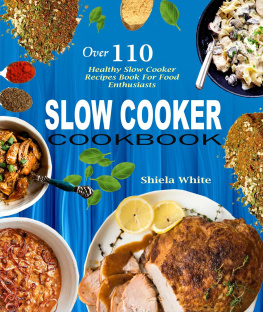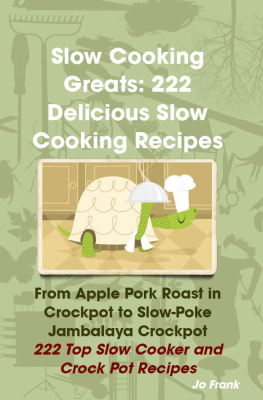CONTENTS
Guide
SALLY WISE is the bestselling author of A Year in a Bottle, Slow Cooker and many other cookbooks which feature delicious preserves and everyday cooking. A regular guest on ABC radio, she runs the Sally Wise Cooking School in the picturesque Derwent Valley in Tasmania.
PAUL McINTYRE is an award-winning playwright whose work has been performed internationally. He is also a senior producer for ABC Local Radio, a feature writer for ABC Online and a radio personality whose expertise ranges from pop culture to ancient history.
 | The ABC Wave device is a trademark of the Australian Broadcasting Corporation and is used under licence by HarperCollinsPublishers Australia. |
First published in Australia in 2017
by HarperCollinsPublishers Australia Pty Limited
ABN 36 009 913 517
harpercollins.com.au
Copyright Sally Wise and Paul McIntyre2017
The right of Sally Wise and Paul McIntyre to be identified as the author of this work has been asserted by them in accordance with the Copyright Amendment (Moral Rights) Act 2000.
This work is copyright. Apart from any use as permitted under the Copyright Act 1968, no part may be reproduced, copied, scanned, stored in a retrieval system, recorded, or transmitted, in any form or by any means, without the prior written permission of the publisher.
HarperCollinsPublishers
Level 13, 201 Elizabeth Street, Sydney, NSW 2000, Australia
Unit D1, 63 Apollo Drive, Rosedale, Auckland 0632, New Zealand
A 53, Sector 57, Noida, UP, India
1 London Bridge Street, London SE1 9GF, United Kingdom
2 Bloor Street East, 20th floor, Toronto, Ontario M4W 1A8, Canada
195 Broadway, New York, NY 10007, USA
ISBN: 978 0 7333 3509 9 (paperback)
ISBN: 978 1 4607 0651 0 (ebook)
National Library of Australia Cataloguing-in-Publication entry:
Wise, Sally, 1951 author.
The little book of slow : live mindfully and enjoy the simple things / Sally Wise, Paul McIntyre.
Includes index.
Subjects: Slow food movement.
Slow life movement.
Electric cooking, Slow.
Sustainable living.
Simplicity (Philosophy)
Other Creators/Contributors: McIntyre, Paul D., author.
Cover and internal illustrations by James Hancock
Cover design by Lisa White, HarperCollins Design Studio
Internal design by Hazel Lam, HarperCollins Design Studio
To all those who love to,
or aspire to, live more mindfully and meaningfully
in our busy modern world.
Sally and Paul first met when Sally became a regular guest on ABC Local Radio in Tasmania for the monthly Jams and Preserves cooking segment. Paul was the producer and they hit it off right from the start. Since then, their friendship has thrived, despite an age difference and quite different lives.
Through their many chats over the years they discovered a shared love for the simple life, one that shuns ostentation or the striving after materialistic goals. Both wanted to live life more slowly and mindfully; to value the quiet moments.
And yet those simple pleasures of life and that more leisurely pace seemed to be constantly just out of reach slipping past them in the hustle and bustle of the modern world.
But the more the conversations continued, the more they realised that this need not be the case. It just takes a new mindset and to remember whats important.
For Sally, its all about getting back to basics: creating and sharing delicious food with family and good friends. Whether its baking bread or a classic apple pie from scratch, preparing a vintage-style high tea or a picnic to enjoy in the great outdoors.
For Paul, its about creating wonderful memories with loved ones by sharing glorious parties, cocktails, leisurely pastimes like board games and keeping memories alive with journals, letters and photos. Paul revels in the fact his home is a refuge from the hustle and bustle, filled with greenery, music and books.
So Sally and Paul have collaborated on The Little Book of Slow, to share what they have found works and hope it inspires others to find their own ways of slowing their lives down and taking the time to enjoy every moment more.

Its very simple to make your own yoghurt. Once youve compared the taste of the homemade version with that of some oversweetened, gum-stabilised commercial varieties, youll wonder why you havent been doing it forever.
EQUIPMENT
You dont need to purchase a yoghurt maker, although it takes the guesswork out of the process. If you dont own one, then you will need a thermometer for best results.
Sterilised jars. I always feel glass is best, but food-safe plastic would suffice. (See Sterilising Jars and Lids on for helpful tips.)
Milk. I dont use low-fat varieties; you can, but it will give a runnier result. Although I havent tried it, Im told you can even use coconut cream. Goats milk works well also, and this I have tried. UHT (ultra heat treated) milk is also suitable for making yoghurt.
Skim milk powder. Always add as directed (usually 2 tablespoons per litre) for advisable extra protein and calcium content.
Starter. Some people use a starter culture, but I just use 2 tablespoons of a previous batch of yoghurt. For your first batch, you could use a good commercial Greek yoghurt, making sure it contains the acidophilus culture.
HOMEMADE YOGHURT
Makes approximately 1kg
3 cups (750ml) full-fat milk
2 tablespoons skim milk powder
2 rounded tablespoons (about 40ml) full-fat yoghurt
Heat the milk to lukewarm (about 43C).
Whisk in the skim milk powder and the yoghurt until smooth.
Pour the mixture into jars, then place in a yoghurt maker or leave in a warm place for 8 hours (at a constant temperature of 4446C).
Put a lid on the jars, and place in the fridge overnight or for about 8 hours before using (this allows it to solidify more).
HINTS AND VARIATIONS
Try mixing some stewed fruits or fresh berries into the yoghurt.
Use plain yoghurt as an accompaniment to an Indian-style dish. I also like to make raita for this purpose, mixing 300ml yoghurt with 1 clove crushed garlic, and a pinch each of salt and cumin. I then grate a cucumber into a clean tea towel, and squeeze out the excess juice. The grated cucumber is mixed into the spiced yoghurt, together with a little chopped fresh red chilli. Delicious!
Add a tablespoonful or two to the dough of homemade bread. It will give a lovely, slightly sour flavour and helps the bread to keep longer.
Add a spoonful to homemade ice-cream mixtures.
Add to smoothies, mashed potatoes and cake batters as part of the liquid component.
Use in salad dressings or to top jacket potatoes, nachos or tacos instead of sour cream.
Put a dollop in the middle of a bowl of a puree-style soup, and sprinkle with chopped fresh herbs.
Make yoghurt cheese (labna) so simple and delicious (see ).
Id often wondered about making cheese: it always seemed like such a homely thing to do, reminiscent of owning a house cow grazing contentedly in the sunshine in a lush green paddock. But for years it remained just one of those artisan activities on my bucket list.

















